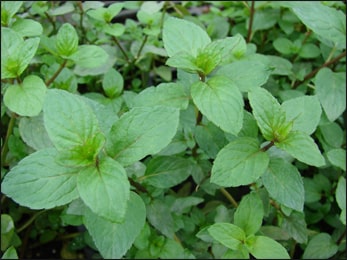
What is Peppermint?
The botanical name of the herb is Mentha piperata and it belongs to the Lamiaceae family. The herb has many health benefits so that’s why Peppermint has been used in many Ayurvedic medicines for the treatment of various body ailments such as diarrhea, cough, dysmenorrhea, pain in joints, indigestion, and fever. The herb has a calming effect on the mind and helps to release your stress and mental pressure. It also acts as a rejuvenating herb. A cup of peppermint tea can help to lose weight, relieve heartburn, induce sound sleep and neutralizes excessive acidity in the stomach. People who are suffering from IBS should have the peppermint tea for at least 2-3 times a day to heal the gut. Menthol is the main potent compound in peppermint which provides cooling property to the herb.
There are more than 25 species of peppermint and it mainly grows throughout North America, Asia, and Europe. The plant is harvested when the oil content in the peppermint is maximum. The medicinal parts of the plants contain volatile oil, phenolic acids, triterpenes, and flavonoids. Peppermint also contains mineral content such as magnesium, potassium, copper, iodine, iron, and sulfur. Along with it peppermint is also a good source of vitamin A, C, niacin, etc. The herb is used as flavoring agent in many food items. So that’s why it is cultivated in many regions of the world.
Peppermint is an herbaceous plant grows up to 30-90cm in length. The leaves of the herb are 4-9cm long and 1.5-4cm and dark green in color. The flowers are purple, 6-8mm long. The plant mainly grows in moist habitats such as near ponds and drainage ditches.
Medicinal Properties of Peppermint
- Rasa (Taste): Katu (Pungent).
- Guna (Qualities): Laghu (Lightness), Ruksha (dry)
- Veerya: (Ushna) Hot in potency
- Vipaka: (Katu) after digestion, it undergoes pungent taste conversion.
- Effect on Tridosha: Balance vitiated Kapha and Vata dosha.
Chemical Constituents of Peppermint
The major chemical constituents of the peppermint are menthol, menthone, pule-gone, menthofuran, 1,8-cineole, isomenthone, menthyl acetate.
Leaves of the peppermint are also a rich source of many compounds such as flavonoids, glycosides, hesperi-din, isorhoifolin, diosmin, eriodictyol 7-O- glucosides, narirutin, besides rosmarinic acid, eriocitrin, luteolin,7-o-rutinside azulenes, choline, and carotenes.
Uses of Peppermint in Different Body Ailments
- The paste of Mentha piperata is used over the joints to get relief from the joints pain and inflammation.
- The fresh juice of mint leaves is drunk with honey to get relief from a cough and sore throat.
- The paste of peppermint is also applied directly over the skin to relieve itching and burning sensation and it also accelerates wound healing.
- The cold infusion of peppermint provides relief from fever and dysmenorrhea.
- The carminative action of mint leaves treats indigestion and colicky pain.
Health Benefits of Peppermint
- Peppermint helps to relax your digestive system and provide relief from pain and other digestive problems. People who are suffering from IBS should add this natural herb to their daily routine. It works wonder for IBS patient and provides relief from symptom such as diarrhea, stomach pain, gastric and bloating problem. Peppermint calms the stomach muscles and also improves the flow of bile. It shows the great carminative effect on your body.
- The herb also shows the relaxing effect on your mind and smooth muscles. Applying peppermint oil directly on your forehead relieves colonic spasm during barium enema. The menthol component of peppermint stimulates the hippocampus area of the brain which is directly associated with mental clarity and memory.
- Peppermint tea provides you deep and sound sleep. The peppermint tea is caffeine free and acts as a muscle relaxant. If you are suffering from insomnia which is a sleep disorder then you should drink 1-cup of peppermint tea daily before going to bed.
- People who have been suffering from severe headache or migraine should drink peppermint tea by adding honey to it. Menthol content In Peppermint increases the blood flow and provides a cooling sensation to the brain and ease the pain. Aroma of peppermint oil and tea relax the muscles and you will get relief from headache.
- Peppermint has antibacterial properties that help to kill the bacteria which causes dental plaque. This herb is also used in many herbal toothpastes and provide a pleasant smell. Due to which it may also treat your bad breath.
- Many dietitians also recommend peppermint tea for those who have been struggling to lose weight. It helps to keep you feel full for a longer period so that you don’t feel hungry for long time. It mainly works on your overall body fats and prevents you from adding extra calories to your body.
- The herb is a rich source of potassium, vitamin B and variety of antioxidant which helps to protect your body from oxidative damage and by doing so it will help to boost your body defense mechanism i.e. immune system.
- The herb act as an expectorant and decongestant. These properties of peppermint help to treat respiratory ailments such as asthma, bronchitis, cough, and sinusitis. The major chemical constituents of peppermint increase the production of saliva and suppress the cough reflex.
Peppermint is the natural potent herb. Along with these properties, the herb also helps to treat problems such as fungal infection, gum disease, bad breath, itching, influenza, cancer, heart disorders etc.
